The Humble Elegance of the Antique Cricket Table: History, Design & Enduring Charm
In the quiet corners of English country homes, you can find a simple but charming piece of furniture: the cricket table. This three-legged table has a round top. It has long been a symbol of rustic charm and smart design. The antique pine cricket table is a special piece. It has warm, honey colors and shows simplicity, strength, and timeless design.
A Brief History: From Tavern Floors to Timeless Interiors
The cricket table began in the early 16th century. It became an important piece of furniture in English country homes. Despite its name, the table has little to do with the sport of cricket. Many theories exist. Some say its tripod shape looks like the stumps of a wicket. Others link the name to the Old English words “cricc” or “cryce,” which mean crutch or staff. Another plausible lineage links it to the “cracket” stool—a small, four-legged seat common in Northumberland mining towns.
Regardless of etymology, the cricket table’s purpose was clear. Its three-legged design offered stability on uneven stone floors, making it ideal for Elizabethan taverns and modest homes. These tables were often made from local hardwoods like oak, ash, and elm. However, pine became a popular choice later on. Its availability and ease of use made it popular. This was especially true in rural areas. In these places, function was more important than decoration.
Design Details: The Beauty of Balance and Simplicity
At first glance, the cricket table looks simple. It has a round top and three splayed legs. These legs are often connected by a stretcher or a shelf underneath. But this geometry is a masterclass in functional design. The tripod base keeps it stable on rough ground. The circular top allows everyone to access it easily. It creates a friendly space for talking, playing cards, or sharing a meal.
Antique pine versions often exhibit a softer aesthetic than their hardwood counterparts. The grain of aged pine, mellowed to a golden hue, carries the marks of time, knots, wear, and patina that speak of generations past. These tables were typically constructed using mortise-and-tenon joinery, sometimes draw-bored for added strength. The legs might be riven from green stock or turned on a lathe, depending on the maker’s resources and regional style.
Some examples have a sculptural base. They feature curved stretchers or slightly angled legs. These details make the rustic form look refined. Others remain delightfully primitive; their charm rooted in asymmetry and hand-hewn authenticity.
The Benefits: Why the Cricket Table Still Matters
In a time of mass production and quick trends, the antique pine cricket table stands out. It reminds us that good design lasts. Here are a few reasons why this humble piece continues to resonate:
-
Stability and Versatility
The three-legged design is inherently stable, making it ideal for older homes with uneven flooring. It’s equally at home in a cottage kitchen, a modern loft, or a curated gallery space.
-
Compact Elegance
Its modest footprint makes it perfect for small spaces. Whether used as a side table, occasional table, or even a plant stand, it adds character without overwhelming.
-
Warmth and Patina
Antique pine, especially when aged naturally, exudes warmth. The mellow tones and tactile surface invite touch and evoke a sense of lived-in comfort.
-
Historical Resonance
Owning a cricket table is like holding a piece of English history. Each one carries the spirit of its maker, the rhythm of its use, and the quiet dignity of its survival.
-
Sustainability
Choosing antique furniture is an environmentally conscious act. It repurposes existing materials, avoids new resource extraction, and celebrates longevity over disposability.
Styling Tips: Bringing the Cricket Table into Contemporary Life
For those curating interiors with a blend of old and new, the cricket table offers endless possibilities. Here are a few ideas:
- In the Entryway: Use it as a perch for keys, mail, or a small vase of seasonal blooms.
- Beside the Bed: Its circular top softens the geometry of a bedroom, offering a gentle alternative to boxy nightstands.
- In the Library: Pair it with a vintage armchair and a reading lamp for a cozy nook.
- As a Display Surface: Showcase ceramics, small sculptures, or treasured objects atop its patinated surface.
Its sculptural quality means it can stand alone, too, an object of quiet beauty that doesn’t need to shout.
What to Look for When Buying
If you’re considering adding an antique pine cricket table to your collection or inventory, here are a few pointers:
- Check the Joinery: Authentic examples often feature traditional mortise-and-tenon joints. Look for signs of handwork.
- Assess the Patina: A rich, even patina suggests age and care. Avoid overly refinished surfaces that strip away character.
- Inspect for Stability: While some wobble is expected in older pieces, the tripod design should still feel secure.
- Consider Provenance: Regional variations exist. Tables from the West Country may differ subtly from those in the North. These nuances add depth to your storytelling.



